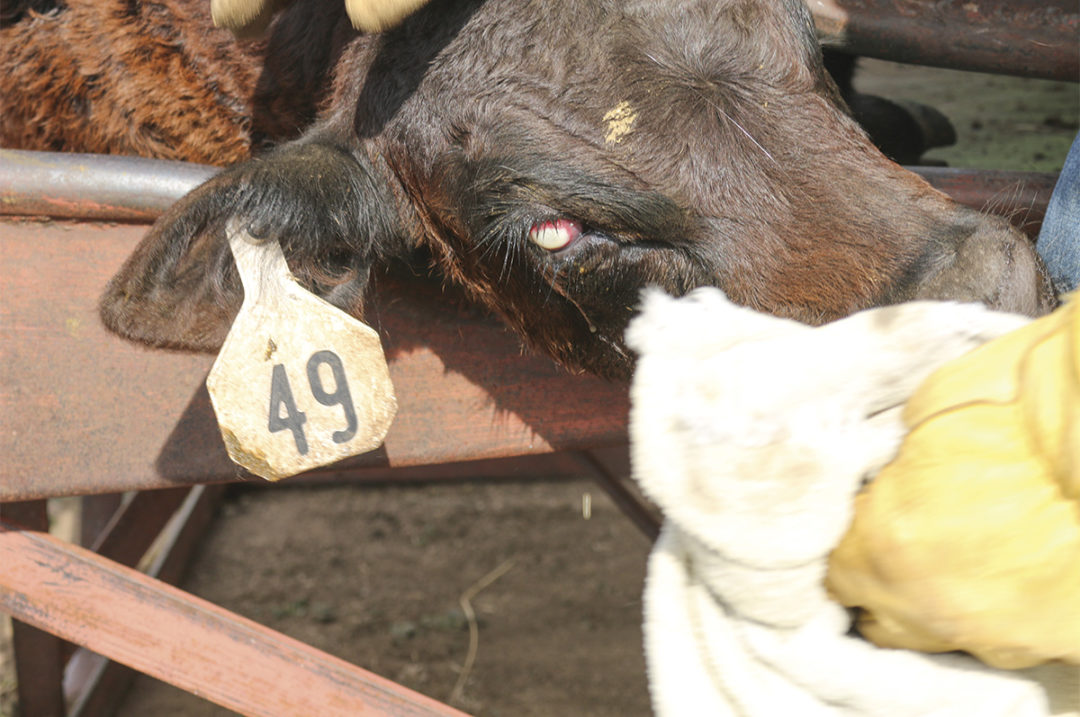Pinkeye is one of the most frustrating diseases we face, and it has a negative impact, not only on the value of cattle but also on their production. Calves with a history of pinkeye, also known as infectious bovine keratoconjunctivitis, have shown to have up to a 40-pound lighter weaning weight than their herdmates.
Unfortunately, unlike other diseases, there is not a single cause, which means there are multiple factors that can lend themselves to an animal developing pinkeye. These include face flies, dust and physical trauma, such as getting poked in the eye when they graze or when they stick their head in a round bale. Breed, age and even bright sunlight are additional factors that contribute to the disease. Each of these affects every animal differently. Of course, the presence of viruses, as well as bacteria such as Moraxella bovis, Moraxella bovoculi, Moraxella ovis and potentially others, take advantage of the eye being compromised. These factors lead to inflammation of the eye and thus what we know as pinkeye. To make matters worse, we’re not just seeing pinkeye in the summer anymore! This past winter there have been reports of winter pinkeye in both beef and dairy cattle, especially in the Upper Midwest.
Fly control
So, what can we do to avoid some of the things that set up the perfect storm that leads to a pinkeye outbreak in our herds? A good place to start would be to implement a good fly control program. This will vary based on your location and management style. The ultimate goal is to reduce the irritation caused by face flies and the exposure to bacteria associated with pinkeye, which flies can carry from one animal to another over longer distances than most of us assume is possible. Options for fly control include insecticide-impregnated eartags, insecticide pour-ons and sprays, back rubbers and feed-through fly control products. If you do use insecticide-impregnated eartags, remember to remove them at the end of the fly season or the end of the active duration as listed by the manufacturer, and rotate different classes of insecticides as part of a judicious ectoparasite control program that you have set up with your veterinarian. Don’t just implement one type of fly control and forget about it. Evaluate your program frequently to determine its effectiveness and make changes as needed.
Mineral program
Having a good mineral program may also help contribute to the prevention of pinkeye in your herd. Selenium, copper and zinc in particular come to mind. Selenium is essential in making antioxidant enzymes that help prevent cellular damage. Plants, both forage and grain crops, are the major source of selenium, and the content in plants is influenced by the concentration and availability of selenium in the soil. Zinc plays an important role in eye health. It is thought to be critical in helping the cells in the cornea hold together tightly, helping to form a barrier against pathogens, as well as playing an important role in overall immunity. In addition, it has been suggested that copper deficiency can also play a role in pinkeye, due to its role in how the immune system responds to invading pathogens, such as bacteria, associated with pinkeye.
Be sure you know what nutrients your pastures, as well as the soil where hay or silage is grown, are likely to be deficient in. This is one of the reasons it is important to work with your nutritionist or veterinarian to design a mineral supplementation program to meet the needs of your cattle. There are some very good ready-made mineral supplements on the market, some of which are formulated specifically for fly control and may contain a feed-through form of fly control as an added benefit. Just remember, there is a high variation in the consumption of free-choice oral trace mineral supplements from one animal to another.
Other preventative measures
Pasture clipping, especially once seedheads emerge, and controlling weeds will help to prevent eye irritation and foreign bodies getting into the eye as cattle graze. It is also important to examine other feedstuffs, such as hay, to determine the potential to cause damage to the eye. We all know some hay contains more stems and thus has a higher potential to damage cattle’s eyes. Unrolling bales of hay instead of setting out round bales in feeders may decrease the risk of mechanical irritation to the eye.
Dust also irritates the eyes, whether it is from a round bale, a gravel road or the pen animals are housed in. In speaking with some veterinarians who are seeing winter pinkeye cases, we think this may be playing an even more important role than during the summer. As animals eat stored feedstuffs in the winter, they are exposed to more dust and other eye irritants.
When possible, providing shade can contribute to the prevention of pinkeye. Certain wavelengths of UV light can cause tearing in and of itself. Studies have shown that radiation damage to the eye is thought to increase the susceptibility of the eye to Moraxella bovis, a bacteria known to cause pinkeye.
Commercial and autogenous pinkeye vaccines are also available. Work with your veterinarian to determine the right vaccine for your herd, which may include taking eye swabs. While pinkeye vaccines are not completely preventative, they may decrease the number and severity of cases and are an important tool in our prevention toolbox. A good infectious bovine rhinotracheitis (IBR) vaccination program is also highly recommended but should be avoided during a pinkeye outbreak. As with any vaccination program, vaccination timing relative to when we expect potential disease to occur and proper handling of the vaccines should be taken into consideration.
Finally, talk with your veterinarian now to get a good prevention program in place. They know what other producers have been facing in your area and what has worked to help reduce the number of cases of this multifactorial disease. What works in the Midwest may not be as effective in other parts of the country. To make matters worse, this disease is ever-changing. What used to be a spring and summer disease is now occurring throughout the year. However, doing what you can to reduce the chance of this multifaceted disease from taking hold in your herd will be worth it in the long run. Preventing pinkeye will save treatment costs, avoid weight gain losses associated with the disease and reduce the potential to get penalized on sale day.
If your cattle do get pinkeye, contact your veterinarian and treat it early. There may be things you can do to reduce the number of cases in your herd, and you’ll want to work with your veterinarian to set up a more robust prevention plan for the future.










